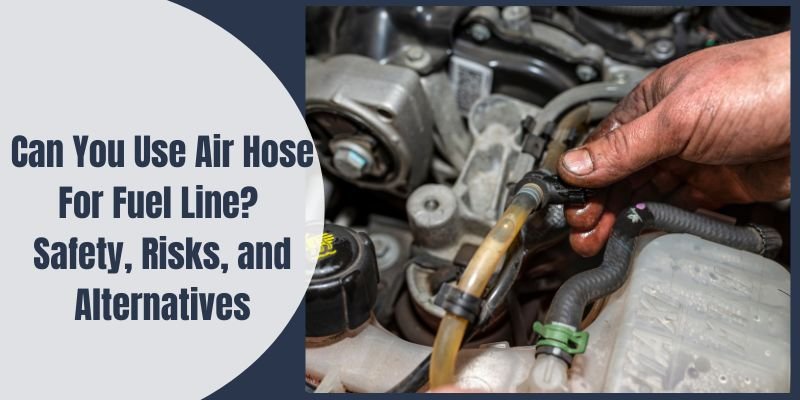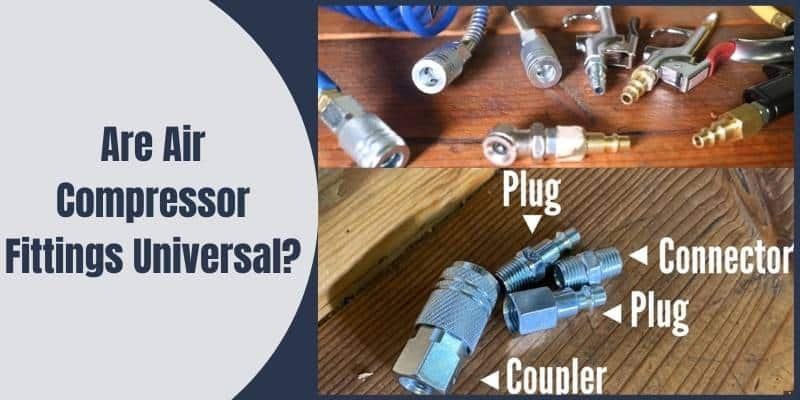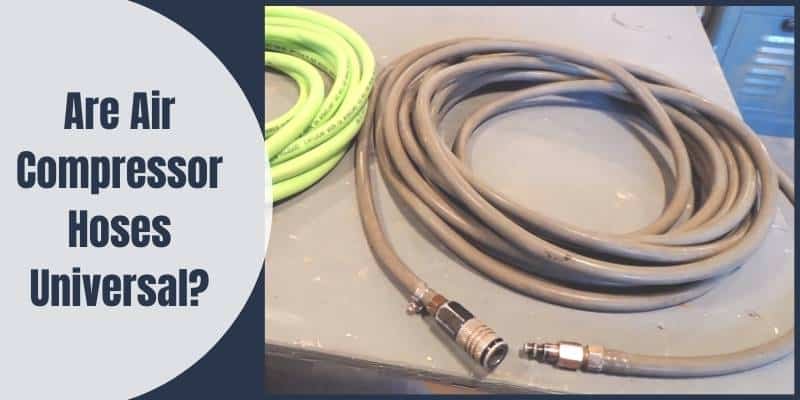Disclosure: This post contains affiliate links and I will be compensated if you make a purchase after clicking through my links. Learn More
When it comes to fuel lines and hoses, ensuring safety and functionality is of utmost importance. Many people wonder if an air hose can be used as a fuel line in certain situations. In this article, we will address the most asked questions about using air hoses for fuel lines.
We’ll explore the advantages, disadvantages, safety considerations, and potential alternatives to using air hoses for fuel applications. Let’s delve into the details!

Can I Use an Air Hose for Fuel Lines?
The short answer is no. Air hoses and fuel hoses are designed differently, and using an air hose for fuel lines can lead to serious safety hazards.
Air hoses are usually made of materials like PVC or rubber, which may not be compatible with the chemicals present in fuel. This could lead to deterioration of the hose material, resulting in leaks, fuel contamination, or even fires.
Using Air Hose for Fuel Line: Safety and Risks
Using an air hose for a fuel line is not recommended and can be highly dangerous. Air hoses and fuel lines are designed for different purposes and have distinct characteristics that make them suitable for their intended applications.
Differences Between Air Hoses and Fuel Lines
- Air hoses are designed to carry compressed air and are constructed using materials that can withstand the pressures and temperatures associated with air compression.
- Fuel lines, on the other hand, are specifically engineered to handle the transport of gasoline, diesel, or other fuels. These hoses are constructed with materials that are compatible with the chemical properties of the fuel and can resist degradation caused by fuel exposure.
Safety Risks of Using Air Hose for Fuel
- Air hoses are not designed to handle the corrosive and chemical nature of fuels. Using them for fuel transfer can lead to hose deterioration, leaks, and fuel system damage.
- The risk of fuel leakage is particularly concerning since fuel leaks can result in fire hazards and environmental pollution.
Fuel Hoses vs. Air Hoses: A Detailed Comparison
Fuel hoses and air hoses serve distinct purposes and must meet specific performance requirements to ensure safety and efficiency. Let’s explore the differences between these two types of hoses:
| Aspect | Fuel Hoses | Air Hoses |
| Material | Nitrile rubber or synthetic compounds | Synthetic rubber or PVC |
| Chemical Resistance | Highly resistant to fuel and oil | Resistant to air and moisture |
| Reinforcement | Multiple layers for strength | Single or multiple layers depending on pressure |
| Pressure Rating | Designed for the pressure of fuel systems | Designed for the pressure of compressed air |
| Temperature Range | Suitable for fuel’s temperature range | Suitable for air’s temperature range |
| Fuel Compatibility | Specifically designed for fuel transport | Not compatible with fuel and may degrade with fuel exposure |
| Color | Typically black or green for easy identification | Various colors, often bright for visibility |
The table highlights the significant differences between fuel hoses and air hoses, emphasizing why using air hoses for fuel lines is hazardous and ill-advised.
Potential Risks of Using Air Hose for Fuel Transfer
Using air hoses for fuel transfer can lead to several risks and complications, posing serious safety concerns. Some potential risks include:
Fuel Leaks: Air hoses lack the chemical resistance required to handle fuel, leading to leaks and potential spills.
Hose Deterioration: Contact with fuel can cause air hoses to deteriorate rapidly, compromising their integrity.
Fire Hazard: Fuel leaks near hot surfaces or sparks can lead to fire hazards and dangerous accidents.
Environmental Pollution: Fuel spills resulting from hose failure can lead to environmental contamination.
Fuel System Damage: Using the wrong hose can cause damage to the fuel system components.
Loss of Efficiency: Inappropriate hoses can result in decreased fuel flow and system efficiency.
To ensure safety and compliance with regulations, it is crucial to use hoses specifically designed and rated for fuel transfer applications.
The Importance of Proper Hose Selection for Fuel Applications
Selecting the appropriate hose for fuel applications is crucial to ensure safe and efficient fuel transfer. Fuel hoses are engineered to handle the chemical properties and pressures associated with various fuels, providing durability and reliability.
Key considerations for hose selection for fuel applications include:
Fuel Compatibility: Ensure that the hose material is compatible with the specific fuel type being transferred.
Pressure Rating: Choose a hose with a pressure rating suitable for the fuel system’s operating pressure.
Temperature Range: Select a hose that can handle the temperature range of the fuel being transferred.
Reinforcement: Consider the number of reinforcement layers necessary to withstand pressure and prevent hose collapse.
Certifications and Standards: Look for hoses that meet industry standards and certifications for fuel transfer applications.
Installation and Maintenance: Proper installation and regular maintenance are essential for the longevity and performance of fuel hoses.
By using hoses specifically designed for fuel applications, users can mitigate risks, ensure safety, and maintain the integrity of their fuel systems.
Understanding the Materials Used in Fuel Hoses and Air Hoses
Fuel hoses and air hoses are constructed using different materials to cater to their unique requirements.
Materials Used in Fuel Hoses
- Fuel hoses typically use nitrile rubber or other synthetic compounds that offer excellent resistance to fuel and oil.
- These materials are engineered to withstand the chemical properties of various fuels and prevent degradation.
Materials Used in Air Hoses
- Air hoses are commonly made from synthetic rubber or PVC, offering resistance to air and moisture.
- These materials are selected to handle the pressures associated with air compression.
It’s crucial to note that the materials used in fuel hoses are specifically chosen for their compatibility with fuels and their ability to maintain integrity over time. Using air hoses for fuel transfer can lead to material degradation, posing significant safety risks.
Legal and Regulatory Considerations for Fuel Hoses
When it comes to handling hazardous materials like fuels, compliance with legal and regulatory requirements is essential. Using the appropriate hoses designed for fuel transfer is often mandated by industry standards and local regulations.
The following are some legal and regulatory considerations for fuel hoses:
Industry Standards: Industry organizations may establish standards for fuel hoses to ensure safety and performance.
Fire Codes: Fire codes and regulations may dictate the use of approved hoses for fuel transfer to prevent fire hazards.
Environmental Regulations: Using the correct hoses can help prevent fuel spills and environmental pollution, complying with environmental regulations.
Inspections and Certifications: Regular inspections and certifications may be required to ensure hose compliance with safety standards.
Failure to comply with these regulations can result in fines, penalties, and increased risks to personnel, property, and the environment.
Risks of Using the Wrong Hose for Fuel Transfer
Using the wrong hose for fuel transfer can lead to several risks, jeopardizing safety, and system integrity. Some of the risks include:
Hose Failure: Incompatible hoses may deteriorate quickly, leading to hose failure and potential fuel leaks.
Fuel Contamination: The wrong hose material may react with the fuel, causing contamination and potential engine damage.
Increased Maintenance Costs: Hose failure and system damage can lead to higher maintenance costs.
Safety Hazards: Fuel leaks can create fire hazards and endanger personnel and property.
System Inefficiency: The wrong hose can lead to decreased fuel flow, resulting in reduced system efficiency.
To prevent these risks, always use hoses specifically designed for fuel transfer and ensure they meet industry standards and regulations.
Can Air Hoses Handle Fuel Line Pressure and Temperature?
Air hoses are not designed to handle the pressures and temperatures associated with fuel lines. Air hoses are constructed to handle the pressures of compressed air, which are significantly lower than the pressures found in fuel lines.
Additionally, fuel lines operate under specific temperature ranges determined by the fuel being transferred. Air hoses may not have the required temperature resistance to handle these extreme conditions.
Using air hoses for fuel lines can lead to hose failure, leaks, and potential safety hazards due to the mismatch in pressure and temperature capabilities.
Are There Any Safe Alternatives?
Yes, there are specific hoses designed explicitly for fuel applications, and these are the safe alternatives to air hoses. Fuel hoses are constructed with materials that can withstand the chemical properties of various fuels, ensuring durability and safety. When dealing with fuel-related tasks, always opt for hoses explicitly labeled and rated for fuel use.
How Can I Identify a Fuel Hose?
Fuel hoses are typically labeled with specific markings and certifications. Look for markings like “Fuel Line,” “SAE 30R6,” or “SAE 30R7.” These designations indicate that the hose is suitable for carrying fuel and complies with industry standards.
Industry Standards for Fuel Hoses: A Necessity
Industry standards play a critical role in ensuring the safety and performance of fuel hoses. Hoses that meet industry standards are specifically designed and tested for fuel transfer applications.
Common industry standards for fuel hoses may include:
- SAE J30: This standard addresses the performance requirements for fuel and oil hoses.
- UL 330: UL 330 establishes safety standards for fuel dispensing hoses.
- ISO 7840: ISO 7840 outlines requirements for hoses used in small craft fuel systems.
- EN 1360: EN 1360 is a European standard for hoses designed for petroleum-based products.
- ASTM D380: ASTM D380 is a standard test method for rubber hose for automotive air and vacuum systems.
Compliance with these industry standards ensures that fuel hoses are manufactured and tested to withstand the demands of fuel transfer applications, mitigating safety risks.
Conclusion
Using air hoses for fuel lines is a dangerous practice that can lead to serious safety risks, including fuel leaks, fires, and environmental pollution. Air hoses and fuel hoses are designed for different purposes, and their materials, construction, and performance characteristics are not interchangeable. Proper hose selection is crucial to ensure the safe and efficient transfer of fuels while complying with industry standards and regulations. By using fuel hoses specifically designed for the task and meeting the necessary safety standards, individuals and industries can minimize risks, enhance safety, and protect their personnel, equipment, and the environment.
Some FAQs About Can You Use Air Hose for Fuel Line
What Should I Do If I Accidentally Used an Air Hose for Fuel?
If you mistakenly used an air hose for a fuel application, it’s crucial to address the situation immediately:
Stop Use: Discontinue using the air hose for fuel immediately to prevent further complications.
Inspect for Damage: Check the hose for any signs of damage or degradation, and replace it if necessary.
Clean the System: If fuel contamination is suspected, have a professional mechanic clean the fuel system thoroughly.
Monitor for Issues: Keep an eye on the fuel system for any abnormalities and address them promptly.
Can You Repair a Damaged Fuel Hose?
It is generally not recommended to repair a damaged fuel hose. Fuel hoses are critical components of the engine’s fuel delivery system, and compromising their integrity can have severe consequences. If a fuel hose is damaged, it’s best to replace it with a new one that meets the required specifications.
Can You Use Fuel Hose for Air Applications?
While fuel hoses are designed to withstand the demands of fuel systems, they can typically handle air applications as well. However, air hoses may be more suitable and cost-effective for air-related tasks due to their specific construction and material design.


